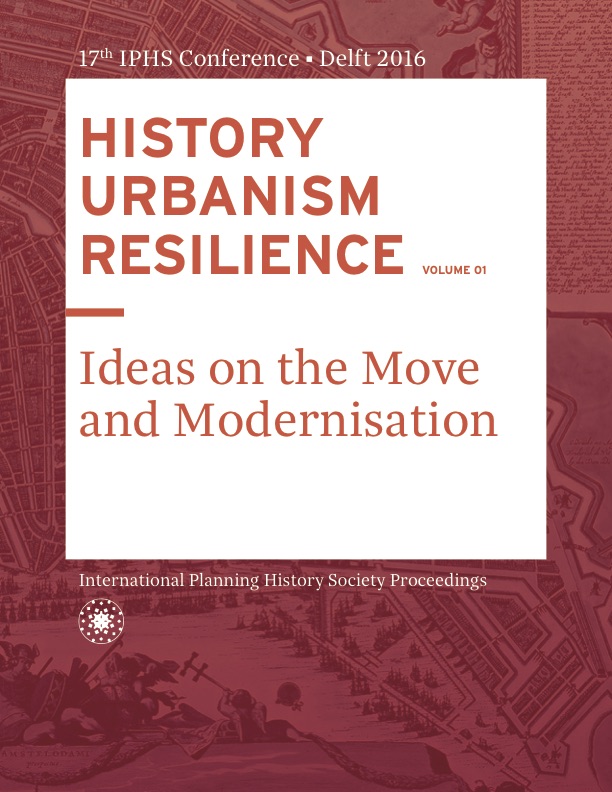(UN)HEALING THE URBAN SCAR IN NICOSIA: SPATIAL AND SOCIAL TRANSFORMATION IN POST CONFLICT DIVIDED CITIES
DOI:
https://doi.org/10.7480/iphs.2016.1.1216Abstract
Urban seperation of cities mostly resulted by the political and ethnic conflict is not considered a lasting solution. When a political solution couldn’t be achieved, where it is mostly seen as a necessity for cooperative urban and social infrastructure, the temporary solution for the city’s divided landscape and everyday life becomes permanent. Hence divided cities are arenas where issues around urban resilience and (re)production of space under contested states are more than everyday debate.
Nicosia widely known as the last divided capital city in Europe serves as the capital of Turkish Cypriots in the north and Greek Cypriots in the south. The United Nations (UN) Buffer Zone formalized in 1974 as an emergency measure against inter-communal clashes has bisected the Walled City Nicosia seperating its citizens and breaking the urban unity. The union of the two communities on Cyprus had been broken up and the continuity of space had then become a past. Nicosia Master Plan (NMP) the cooperative planning initiative of the professionals that had been managed before political consensus is reached, had created a unique solution for the city. The success of NMP in physical terms stayed limited as the division continued. In 2008 with the opening of the Ledra Gate within the Walled City had symbolic meaning as it will make the two communities feel as if they belong to the united urban texture and have the potential of giving chance to new socio-economic developments and for daily interactions. Civil actors from formal and informal groups have gradually stepped forward to strenghten the positive effect of the NMP; bringing life to the Dead Zone of the city.
The recent spatial and social transformations along the divide of Nicosia are scrutinized in this paper. It explores the policy and planning responses that are being proposed in divided cities and the solution efforts that is promoted by professionals, citizens and NGO’s more than the states. The analysis is based on qualitative data; the visual and verbal records centered on activities and actions of NMP and NGO’s on the field. Within this context the paper focuses on intentions and concrete steps where the Buffer Zone is perceived as a shared space. It also aims to point out an insight for social and spatial (re)production in post conflict divided cities.
References
Attalides, Michalis. Social Change and Urbanization in Cyprus: A Study of Nicosia, Nicosia: Publications of the
Social Research Centre, 1981.
Bollens, Scott A. City and soul Sarajevo, Johannesburg, Jerusalem. City, 5(2), 169-187, 2001.
Broome, Benjamin. A Guide to Intercultural Communication in Cyprus. Nicosia: United Nations Development
Programme, 2005.
Chelleri, Lorenzo, Waters, J. J., Olazabal, M., & Minucci, G. Resilience Trade-offs: Addressing Multiple Scales
and Temporal Aspects of Urban Resilience. Environment and Urbanization, 27(1), 181–198, 2015.
http://dx.doi.org/10.1177/ 0956247814550780 Clements, F. E. (1936). Nature and structure of the climax. Journal of Ecology, 24(1)
Constantinou, Costas, Papadakis, Yiannis. The Cypriot State(s) in situ: Cross-ethnic Contact and the Discourse
of Recognition. Global Society, 15(2), 125-148, 2001.
Demetriades, Lellos. The Nicosia Master Plan. Journal of Mediterranean Studies, 8(2), 169- 176, 1998.
Folke, Carl. Resilience: The Emergence of a Perspective for Social–Ecological Systems Analyses. Global
Environmental Change, 16(3), 253–267, 2006. http://dx.doi. org/10.1016/j.gloenvcha.2006.04.002
Foka, Zinovia. Shared Space in Conflict Areas: Cultural Processes of Space Appropriation in Nicosia’s Walled
City, Paper presented at the RC21 International Conference on “The Ideal City: between myth and
reality. Representations, policies, contradictions and challenges for tomorrow’s urban life” Urbino (Italy) 27-29 August 2015. http://www.rc21.org/en/conferences/urbino2015/
Foucault, Michel. Of Other Spaces: Utopias and Heterotopias, in Leach N (Ed.) Rethinking Architecture A
Reader in Cultural Theory. London: Routledge, 330-357, 1997.
Gurdalli Huriye, Koldas Umut. Architecture of Power and Urban Space in a Divided City: A History of Official
Buildings in Nicosia/Lefkoşa, The Design Journal: An International Journal for All Aspects of Design,
Volume 18, Issue 1, 2015, 135-157, 2015.
Hadjichristos, Christos. Cyprus: Nicosia and its d-Visions. Architectural Design, 76(3), 12-19, 2006.
Hadjipavlou, Maria. Multiple Stories: The ‘Crossings’ as Part of Citizens’ Reconciliation Efforts in Cyprus?
Innovation, 20(1), 53-73, 2007.
Harvey, David. Sosyal Adalet ve Şehir / Social Justice and the City. İstanbul: Metis, 2003.
Holling, Crawford S. Engineering Resilience Versus Ecological Resilience. In P. Schulze (Ed.), Engineering
within ecological constraints. Washington, DC, USA: The National Academies Press, 1996.
Klein, Richard., Nicholls Robert J., Thomalla Frank. Resilience Towards Hazards: How Useful is This Concept?.
Global Envionemntal Change Part B: Environmental Hazards, Volume 5, Issues 1-2, 35-45, 2003.
Kliot, N., & Mansfield, Y. The political landscape of partition: The Case of Cyprus. Political Geography, 16(6),
-521, 1997.
Matyas, David., Pelling, Mark. Positioning Resilience for 2015: The Role of Resistance, Incremental Adjustment
and Transformation in Disaster Risk Management Policy. Disasters, 39(SI), 1–18, 2014.
http://dx.doi.org/10.1111/disa. 12107
Meerow, Sara, Newell Joshua P., Stults Melissa. Defining Urban Resilience: A Review. Landscape and Urban
Planning 147, 38–49, 2016.
Nicosia Master Plan Bi-communal Team. Walled Nicosia: A Guide to its Historical and Cultural Sites, 2005.
Nicosia Master Plan. Nicosia Master Plan Final Report. Nicosia: UNDP UNCHS (HABITAT), 1984.
New Vision for the Core of Nicosia Diagnostic Report Executive Summary. Nicosia: BiCommunal Development
Programme, 2004.
New Vision for the Core of Nicosia Final Report. Nicosia: Bi-Communal Development Programme, 2004.
New Vision for the Core of Nicosia Outline Plan. Nicosia: Bi-Communal Development Programme, 2005.
Oktay, Derya. An Analysis and Review of the Divided City of Nicosia, Cyprus and New Perspectives,
Geography, 231-247, 2007.
Papadakis, Yiannis. Nicosia After 1960: A River, A Bridge and a Dead Zone. Global Media Journal:
Mediterranean Edition, 1(1), 1-16, 2006.
Suri, Shipra Narang, In-conflict/post-conflict: A Role for Planning in Building Peaceful, Inclusive and Resilient
Cities, Planning and Post-Conflict Cities Symposium, 9 December 2015.
İsocarp.org/post-conflict-planning-inclusive-resilient cities
The Nicosia Sewage Project, a Plan for Nicosia, a Strategy for the World. Nicosia: UNDP UNCHS
(HABITAT), 1995.
Walker, Brian, Holling C S, Carpenter Stephen, Kinzig Ann. Resilience, Adaptability and Transformability in
Social–ecological Systems. Ecology and Society 9(2): 5, 2004.

